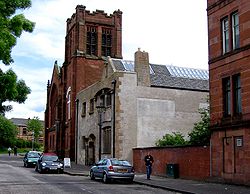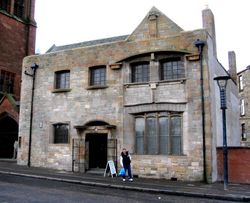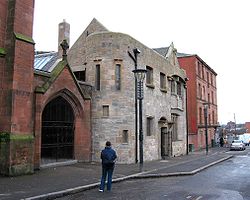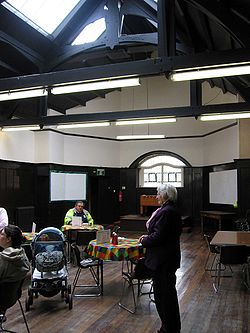
Ruchill Church Hall
Encyclopedia



Charles Rennie Mackintosh
Charles Rennie Mackintosh was a Scottish architect, designer, watercolourist and artist. He was a designer in the Arts and Crafts movement and also the main representative of Art Nouveau in the United Kingdom. He had a considerable influence on European design...
, was built as a mission for the Free Church of Scotland
Free Church of Scotland (1843-1900)
The Free Church of Scotland is a Scottish denomination which was formed in 1843 by a large withdrawal from the established Church of Scotland in a schism known as the "Disruption of 1843"...
and completed in 1899. It is located at 15/17 Shakespeare Street, a side road off Maryhill Road, Glasgow
Glasgow
Glasgow is the largest city in Scotland and third most populous in the United Kingdom. The city is situated on the River Clyde in the country's west central lowlands...
, Scotland
Scotland
Scotland is a country that is part of the United Kingdom. Occupying the northern third of the island of Great Britain, it shares a border with England to the south and is bounded by the North Sea to the east, the Atlantic Ocean to the north and west, and the North Channel and Irish Sea to the...
, close to the bridge which takes Ruchill Street across the Forth and Clyde Canal
Forth and Clyde Canal
The Forth and Clyde Canal crosses Scotland, providing a route for sea-going vessels between the Firth of Forth and the Firth of Clyde at the narrowest part of the Scottish Lowlands. The canal is 35 miles long and its eastern end is connected to the River Forth by a short stretch of the River...
to the Ruchill
Ruchill
Ruchill is a district in the city of Glasgow. It lies within the Canal Ward of North Glasgow in the area between the Maryhill and Possilpark areas of the city. It has traditionally been characterised by a high degree of deprivation and social problems...
area, and near a shopping centre on the main road. The adjacent church closer to the canal was constructed later, designed by a different architect.
The building provides two halls, with the main hall having a section divided off by a sliding folding partition, and two committee rooms. It is in active use by the congregation of the church, and is open daily providing community facilities as well as a "Mackintosh Tea Room" providing teas and snacks in the main hall for anyone wanting to visit.
Entering from Shakespeare Street, a committee room is to the right, while to the left a passageway leads past a screened washbasin to a door to the stairwell. Next on the left is a small kitchen / servery, while straight ahead from the main entrance doors lead into the corner of the main hall. On the right a large bay is separated off from the main main hall with a sliding folding partition incorporating high level glazed panels with Mackintosh's characteristic stained glass inserts.
The stair leads up to a short corridor past toilet facilities located above the kitchen, leading to an upper committee room directly above the committee room downstairs, and to an upper hall above the bay off the main hall. These two rooms are separated by a sliding folding partition which can be opened to form one long rectangular space. The roof structure to the upper committee room and hall is exposed, with roof lights to both rooms, and its gable forms a strong shape to the right of the front elevation.
The hall is notable for the unusual distinction of having a clear representation of a human face in its main elevation, although it is unclear whether this was deliberate on the part of the architect.


